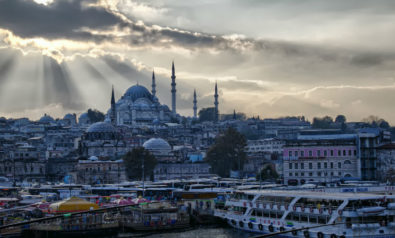In an era where media reporting simplifies everything, we need to remember that threats of terrorism come from both Islamism and the extreme right.
How seriously should we take the risk of violent extremism emanating from the extreme right? The UK has seen a notable rise in hate crimes since Brexit. Its most serious extreme-right incidents in the past few years include the murder of the parliamentarian Jo Cox in June, attacks by Zack Davies—convicted in 2015 of attempted murder and linked to the group National Action—and Pavlo Lapshyn, an avid reader of The Turner Diaries who was imprisoned for 40 years in 2013 for a murder and planting a series of bombs at mosques.
In America, gunmen such as Dylann Roof and Wade Page can also be cited as particularly evocative, recent examples of men radicalized by extreme-right ideas. The USA too has also seen a rise in anti-Muslim, anti-LGBT and other types of hate crime in 2016. Looking to the future, what sorts of terrorist threat does the extreme right pose? How important is this issue when compared to other forms of political violence? Is enough being done to tackle violence form the extreme right?
Looking the Wrong Way
When talking about political violence, it is not unusual for reports from respected organizations to warn that threats posed by the extreme right need to be taken more seriously. They often include statements noting such findings are needed in order to correct a perceived lower level of threat from extreme-right terrorism, compared to Islamist violence—a misconception found among the public and policymakers alike.
For example, in 2015, the Southern Poverty Law Center (SPLC) published an analysis of lone-wolf terrorism that highlighted most of America’s domestic terrorists since 2009 are not linked to larger organizations. It also stressed that “half of the attacks during the period apparently were motivated by the ideology of the antigovernment ‘Patriot’ movement, including ‘sovereign citizens,’ whose movement has been described by the FBI as ‘domestic terrorist.’ A little more than that (51%) came from ideologies of hate, ranging from white supremacy to misogyny to radical Islamism.”
Meanwhile, another recent study of lone-actor terrorism, by the Royal United Services Institute (RUSI) and focused on Europe, highlights that, when compared to religiously inspired perpetrators, those influenced by the extreme right in Europe were actually more likely to be deadly. It also stated that “33 per cent were classified as right-wing extremists, while 38 per cent were religiously inspired,” suggesting that each threat represents a similar level of concern. Recognizing the extreme right was one among a range of threats in Europe, their assessment tellingly stated that “Rightwing extremists represent a substantial aspect of the lone actor threat and must not be overlooked.”
While it would be too much of a leap to conclude from such reports arguing for greater awareness of extreme-right terrorism that states and security services simply ignore the issue, it is clear that it can often be deemed of secondary importance. This is a misconception supported by the much greater intensity of media reporting on Islamist-inspired terrorism compared with other types of threat. As such, people often know very little about what underlying ideas drive political violence from the extreme right.
Scavenger Ideology
To comprehend the threat posed by the extreme right, it is crucial to understand its core ideology. In the UK, the Prevent Strategy, part of the country’s counter-terrorism policy framework focused on counteracting extremist perspectives, rightly stresses that “radicalisation is driven by an ideology which sanctions the use of violence.” Like other terrorists, extreme-right activists are often motivated by more than mere hate, and do consider themselves driven by a set of ideas. Nevertheless, it is worth reflecting on what “ideology” actually means in extreme-right contexts.
Ideas about politics and society matter for the extreme right, but perhaps not in the same way as they matter for those of a more moderate political persuasion. For those within the extreme right, strong opinions on political and social issues are often used primarily as ways to give meaning to action, from sustaining a diverse subculture to licensing political violence.
It is also perhaps surprising that, on close inspection, there are countless variants of radical and extreme-right ideas, many of which are not really compatible with each other. Yet this does not stop activists within the movement from holding views that clash with each other. For the uninitiated, this is often confusing and, at times, quite bewildering. George L. Mosse coined the term “scavenger ideology” to describe the way such extremisms annex various, ultimately incompatible ideas from across the political and cultural spectrum, and retool them for their own purposes and to inspire action.
Extreme-right ideology usually evokes the idea of a once “pure” society facing impeding doom. In particular, extreme-right ideologues like to argue that society is in a state of undisclosed civil war, and often claim that white people are victims of a hidden genocide.
For the extreme right at least, ideology does not necessarily need to be a rich, nuanced and complex political worldview (though some examples of extreme-right ideology can be surprisingly sophisticated). Usually, though, what is really being talked about in terms of extreme-right ideology is an evocative set of themes, or tropes, given added depth by some quite basic writings all too easily available online. These core, underlying tropes come to form elements of a worldview that can be strung together to make people who subscribe to variants of extreme-right ideology think they are engaged in an exciting, even momentous, battle to save a society from total destruction.
Core Elements of Extreme Ideologies
Some of the standout, recurrent tropes within extreme-right ideas include the following: an us versus them mentality; conspiracy theories; the idea of society facing an existential threat; and the need for a revolution. These ideas can be articulated and developed in numerous ways, from crude white supremacist websites to engagement with philosophers such as Martin Heidegger.
Us versus them: One way or another, extreme-right ideologies are framed around the idea of a heroic few fighting against a political and social system that is designed to ensure they remain suppressed. A language of marginalization, and being outsiders, is quite typical of the extreme right.
Of course, all political ideologies have a sense of identifying friends and enemies. However, the extreme right frames this in a highly-polarized manner and tends to view swathes of wider society as either “traitors,” complicit in keeping their movement down, or “idiots” unable to see through lies and propaganda. Nicholas Goodrick-Clarck has written about this Manichean element to the extreme right in his book Black Sun: Aryan Cults, esoteric Nazism and the Politics of Identity.
Conspiracy theories: Linked to this sense of marginalization and victimhood is usually a conspiracy theory of some sort or another. In Europe, the Counter-Jihad Movement often focuses on the theme of cultural Marxism—an idea Anders Behring Breivik explored at great length in his manifesto. Neo-Nazis on the other hand tend to focus on the idea of a Jewish plot to control the world, derived from Nazi and other interwar forms of anti-Semitic conspiracism created by earlier generations of fascists. Other conspiracy theories include the ideas of the Sovereign Citizens movement. The conspiracy theory is crucial, as it explains why their movement is so marginalized. Jérôme Jamin, among others, has examined this element of the extreme right in some considerable depth.
An existential threat facing society: The rhetoric of the extreme right usually does not simply consider the forces of suppression to be content with marginalizing their movement either. Extreme-right ideology usually evokes the idea of a once “pure” society facing impeding doom. In particular, extreme-right ideologues like to argue that society is in a state of undisclosed civil war, and often claim that white people are victims of a hidden genocide.
If believed, these ideas can be quite powerful, helping those who wish to carry out violence think about their actions as not, ultimately, aggressive, but rather as defensive—no matter how paranoid this may seem. Also, this defensiveness helps fuel the particularly visceral racism of the extreme right, seeing those who are not white as not merely “other” but also posing some sort of existential threat to an extreme ideal of racial “purity.” The role of existential threats is extreme-right and fascist propaganda has been discussed at length by Aristotle Kallis, who sees this element as crucial for licensing political violence.
Revolution: Finally, while the present day is seen through the lens of a society falling into a state of corruption and decay, at the hands of both conspirators and a hapless wider public, the extreme right likes to think the future could be radically different. Typically, extreme-right fantasy novels such as The Turner Diaries articulate a narrative of revolution. Moreover, texts such as this, as well as non-fiction material such as Breivik’s manifesto, project into the future a trajectory setting out the “purification” of society, achieved through revolutionary violence. In this imagined future, those deemed “traitors” will be eliminated, those deemed not racially “pure’ will be expunged in one way or another, and those deemed to be duped by the “propaganda” of the current system will be liberated and thankful.
For the activists who want to turn their beliefs into some form of action, the fantasy of the violent protagonist as some form of “hero,” a man of destiny, a plucky underdog taking on the forces of perceived oppression in the name of freedom, is common identity. The ways that terrorists can perceive themselves as self-styled “heroes,” believing they are characters uniquely infused with powers to carry out an acts genuinely capable of changing the world, has been explored by Roger Griffin in his book Terrorist’s Creed, among others.
What About Mental Health?
While extreme-right ideologies can take many forms, they do tend to manifest elements of the underlying themes, or tropes, discussed above, in order to create exciting, dynamic scenarios justifying violence. These ideas are refreshed by a highly variegated, complex wider extreme-right milieu too, which consists of myriad specific groups, networks and websites.
Extreme-right activists who are about to turn to violence are particularly difficult to spot, as they undergo less obvious behavioral changes than Islamist terrorists, but still may disclose their intentions online.
It would be a mistake, then, to see the ideas used to justify extreme-right political violence as simply the product of some form of psychosis. Nevertheless, research into the mental health of extreme-right protagonists who carry out violence does often point to some form of mental health vulnerability. Does ideology or mental health issues, then, “explain” extreme-right violence?
While it is unhelpful to generalize about what will trigger someone to step over the line and carry out acts of political violence, it is clear that those individuals and small groups who do so from the extreme right tend to have a mental health concern of some description. This may be depression, as in the case of David Copeland, who killed three people in 1999 but was still found guilty. This issue was also a feature of the trial of Breivik, who suffered from a narcissistic personality disorder but was still deemed legally responsible for his actions.
In other words, care needs to be taken with discussions on mental health and political violence. It is important not to explain away violent extreme-right protagonists by identifying mental health issues. These can play a part, but so does the ideology promoted by the wider extreme-right movement. Moreover, while mental health issues are important, figures such as Ramon Spaaij highlight their role varies from case to case, and mental health vulnerabilities tend not to absolve violent protagonists.
Monitoring the Fringes
Extreme-right ideas will continue to circulate, and in the era of social media the extreme-right’s core activists are finding their ideas are easier to spread than ever. Moreover, the rise of impactful, populist political movements in Europe (UKIP, Front National, Party of Freedom, etc.) and America (the Tea Party movement and now Donald Trump) are only helping to popularize watered-down versions of more extreme agendas, normalizing many extreme-right themes.
To help deal with this threat, there certainly needs to be renewed efforts to monitor the extreme right by security services. Extreme-right activists who are about to turn to violence are particularly difficult to spot, as they undergo less obvious behavioral changes than Islamist terrorists, but still may disclose their intentions online. Greater monitoring of groups and their online spaces is crucial to keeping on top of this issue.
Moreover, the clunky approach to discussing sub-categories of terrorist threat that basically pits the extreme right against Islamist-inspired political violence for resources needs to be challenged. We live in an era where the media reporting can simplify, but this needs to be resisted. Threats of terrorism do not come from either Islamism or the extreme right. Rather they come from both of these areas (and others), and in the future will do so in unexpected ways.
Finally, politicians need to pay much greater attention to serious reports from organizations such as the SPLC and RUSI that repeatedly highlight the significant levels of threat posed by the extreme right. One effective answer would be to make sure all potentially risky extreme-right groups, networks and organizations are carefully monitored. Rather than seeing security risks as a zero-sum game competing for resources, and in an era of rising hate crimes, if this requires governments to invest more into investigating extreme-right threats, to bring this to a level of parity with Islamist ones, then this needs to happen.
The views expressed in this article are the author’s own and do not necessarily reflect Fair Observer’s editorial policy.
Photo Credit: kenlh
 We bring you perspectives from around the world. Help us to inform and educate. Your donation is tax-deductible. Join over 400 people to become a donor or you could choose to be a sponsor.
We bring you perspectives from around the world. Help us to inform and educate. Your donation is tax-deductible. Join over 400 people to become a donor or you could choose to be a sponsor.
Support Fair Observer
We rely on your support for our independence, diversity and quality.
For more than 10 years, Fair Observer has been free, fair and independent. No billionaire owns us, no advertisers control us. We are a reader-supported nonprofit. Unlike many other publications, we keep our content free for readers regardless of where they live or whether they can afford to pay. We have no paywalls and no ads.
In the post-truth era of fake news, echo chambers and filter bubbles, we publish a plurality of perspectives from around the world. Anyone can publish with us, but everyone goes through a rigorous editorial process. So, you get fact-checked, well-reasoned content instead of noise.
We publish 2,500+ voices from 90+ countries. We also conduct education and training programs
on subjects ranging from digital media and journalism to writing and critical thinking. This
doesn’t come cheap. Servers, editors, trainers and web developers cost
money.
Please consider supporting us on a regular basis as a recurring donor or a
sustaining member.
Will you support FO’s journalism?
We rely on your support for our independence, diversity and quality.


















